Pad Thai is a stir-fried rice noodle dish served and eaten as street food throughout Thailand. It has all the flavor of the signature Thai cuisine- the sourness of tamarind, the sweetness of palm sugar, the saltiness of fish sauce, and the spiciness of the chili pepper. It is so popular that it is served not only along the street but in nearly all Thai restaurants I know. It is perhaps also the most well-known Thai food in the world.
This Pad Thai post is completely rewritten based on my previous work two years ago, with an upgraded recipe and the inclusion of the video demonstration.
I have added more information below:
- The authentic formula of the Pad Thai sauce
- The key ingredients and the explanation of how to prep these items.
- The stir-frying technique is required.
I am keeping the recipe as original as possible and dividing it into small steps you can pause and continue.
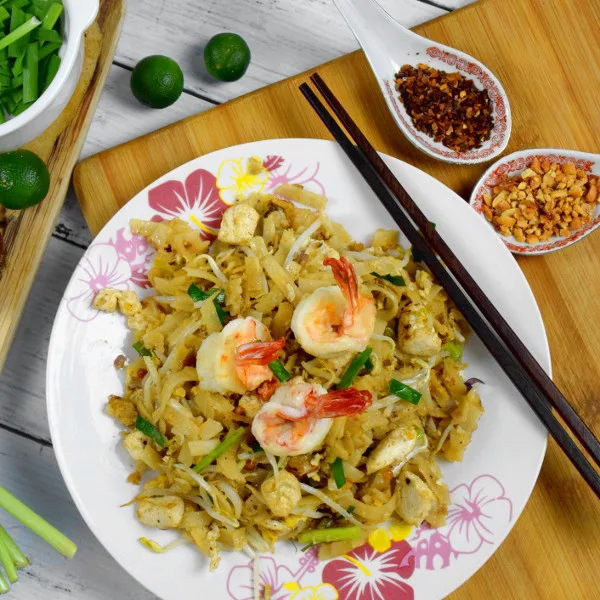
There is nothing that can compare to Pad Thai. If you have ever eaten it, you can likely recall what it tastes like without having to experience it again, but it can be intriguing to put into words. You need to try it only to apprehend the complexity of this flavor.
Once the ingredients are ready, you can cook up the mouthwatering Pad Thai in less than ten minutes.
Let’s get started.
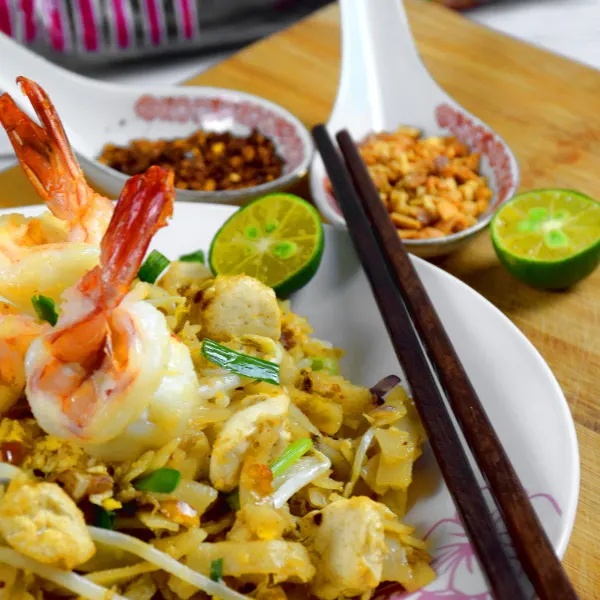
Note: This post may contain affiliate links. Please read my privacy policy for more info. I may receive commissions for purchases made through links in this post. As an Amazon Associate, I earn from qualifying purchases.
Four simple steps to cook up an irresistible Pad Thai
Pad Thai regularly receives high praise from food critics worldwide due to its complexity, affordability, and range of flavors.
This dish has a wide variety of textures that make it an absolute joy to eat. You will experience the soft noodles, the small pieces of crunchy pickles and nuts, and the freshness of bean sprouts.
You will also experience the sourness of tamarind mixed well with the sweetness of palm sugar and the spiciness of hot chili pepper.
Step 1- Soaking the noodles.
Noodles for Pad Thai come in two forms- dry and fresh. Since the noodles are hard to get where I live, I always use the dry ones to prepare the Pad Thai. I think many readers will be in the same situation as me, so please follow the package instructions to rehydrate these flat rice noodles (also called rice stick noodles) before use.
Pad Thai noodles will absorb the water and rehydrate when you soak them in water. Please note that the amount of noodles in the recipe below is the dry weight.
Start soaking the dry noodles in lukewarm or room-temperature water while preparing the other ingredients. The time required depends on the thickness and width of the noodles, as well as the temperature of the water. Some recipes mention that it can soak for a few hours, but I prefer the noodles to be just al dente, as they can become too soft, mushy, and less chewy.
You can use hot water to speed up the rehydration of the noodles.
Here are my steps:
- Put the noodles in a large container. Pour some boiling water until they are covered.
- Submerge the noodles entirely in the water.
- Leave to stand for five to ten minutes. The noodles are ready when they become flexible and no longer transparent. Remove the noodles.
- Rinse the noodles with cold water or under the tap to stop further cooking by the residual heat. Drain and set aside.
You can do this step ahead of time. Toss the noodles with oil to prevent them from sticking together.
By far, the trickiest part is to soak the noodles. Noodles should be somewhat flexible and firm, not wholly expanded and soft. When in doubt, undercooked is better than overcooked. You can stir-fry the noodles longer with some water if it is too hard.
Step 2- Prepare the Pad Thai sauce.
Pad Thai has a unique flavor. Many people cannot pinpoint why they love Pad Thai because it has such an incredible flavor.
This exceptional flavor derives from combining three sauce ingredients- palm sugar, fish sauce, and tamarind juice. Neither of these ingredients is common in western cuisine. Tamarind and palm sugar are rarely used, although the fish sauce is an occasional seasoning for the Chinese. That is why the flavor of Pad Thai is so unusual for non-Thai people.
Let’s take a look at these ingredients one by one:-
Palm sugar
Palm sugar is derived from the sap of the flower buds of the coconut palm. It has a subtly sweet taste similar to brown sugar, with a more intense caramel taste. Many local cuisines and desserts in Sout-East Asia contain palm sugar as the sweetener.
Use palm sugar only to get the authentic Thai flavor. The closest substitute is brown sugar.
Fish sauce
There is no substitute for fish sauce. Fish sauce is produced by fermenting the fish with salt over a few weeks or even up to two years. The process develops an intense umami flavor.
Fish sauce is the only source of salt for Pad Thai. It provides a unique flavor to the noodles. Therefore, a good quality fish sauce is essential for producing the best Pad Thai.
Tamarind paste
Tamarind provides acidity to Pad Thai. You should not use rice vinegar as a substitute, as tamarind has a distinctive flavor.
You can use tamarind paste (or tamarind puree) for this recipe. However, I use tamarind pulp since it is easily available in any local grocery shop.
Note:
There is an easy way out if you think it is troublesome to get these ingredients just for a plate of Pad Thai. There is a ready-made Pad Thai sauce available. The flavor can be significantly different from brand to brand.
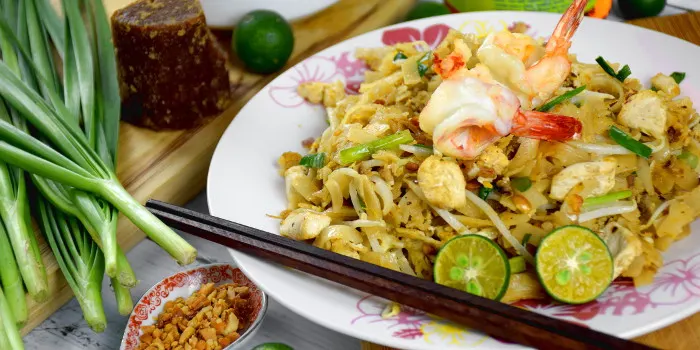
Step 3- Get ready all the ingredients
Most Pad Thai recipes include standard ingredients- tofu, peanuts, chili, sweet preserved pickles, dried shrimp, eggs, Chinese chives, and fresh bean sprouts.
Besides that, it should include some fresh ingredients such as chicken, prawns, crab meat, or just made a vegetarian Pad Thai.
Let’s take a look at these ingredients.
Tofu
The tofu for cooking Pad Thai should be firm as it can break easily into small pieces during stir-frying. This type of tofu is labeled as firm or pressed tofu.
Cut the firm tofu into small pieces, about 1 cm wide x 3cm long. The tofu should be lightly fried in oil over low heat until the surface becomes golden brown. The easiest way is to deep-fry the tofu, but you can pan-fry it with a little more oil to prevent it from sticking to the pan. The fried tofu has a firmer texture which can withstand stir-frying with the noodles.
Peanuts
Crushed peanuts are the standard ingredients for Pad Thai. You can roast the peanut in the oven or pan-fried with minimal oil over low heat until they turn slightly brown.
Remove the skin of the peanuts and crush them with a mortar and pestle. You can also put them in a plastic bag and crush them with the rolling pin.
The crushed peanuts are added to the noodles during the last step of stir-frying or sprinkled on the noodles while serving. Serve the extra crushed peanuts as condiments and as garnish.
Note: You can omit the peanut if you are allergic to it.
Dried shrimp
Dried shrimp are slightly hard and chewy, adding another dimension of texture to the noodles. It has a distinctive savory flavor which is similar to the dried scallop.
Rinse and clean the dried shrimp with water and remove any shells and sand. Cut the dried shrimp into smaller pieces if they are big, or chop them finely.
I leave it as the whole shrimp, but it all depends on your preference.
Preserved radish
Two types of preserved radish are available- sweet and salty. Sweet preserved radish is the correct type for preparing Pad Thai. Most grocery shops in Malaysia sell preserved radish that has been chopped finely. However, some places sell only the uncut preserved radish, and you need to cut it into small pieces before use.
Chinese chives and bean sprouts
Chinese chives and bean sprouts are added last in the stir-frying process. In fact, many fried noodles in Asia use chives and bean sprouts too. For example, The Penang Char Keow Teow is one that uses a lot of chives and bean sprouts, and the Singapore fried noodles are no exception.
Add most of the bean sprouts to the noodles while frying. The bean sprouts will help to prevent the noodles from sticking to the wok. However, they will wilt off and become soft. Therefore, reserve one-third of the bean sprouts and add to the noodles right before turning off the heat to preserve the crunchiness.
Note: The authentic version does not include bell pepper in the recipe.
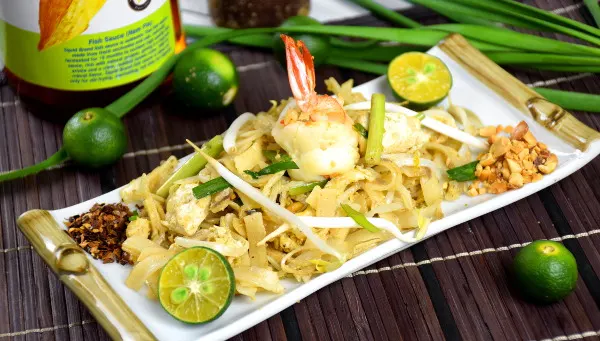
Step 4- Stir-fry and serve
We have everything in place, and it is ready to turn on the heat and stir-frying.
Here are the steps:
- Heat some vegetable oil in the wok. (Use a large frying pan or a large nonstick skillet if you do not have one.) Fry the tofu until golden brown. Remove and set aside. It is advisable to use a large wok than a small one. You need space to move around the morsel of food in the wok and to push the noodle to the side when you add the beaten eggs to the center of the wok.
- Add some vegetable oil to the wok if necessary. Pan-fry the prawns over low to medium heat until both sides turn golden brown. Do not move the prawns around in the wok, so they are sheared nicely. Flipping over only once should be good enough. Remove the shrimp and set aside.
- Saute chopped shallots and minced garlic over low heat until fragrant with the prawn oil. Add the dried shrimp, red pepper flakes (chili flakes), and preserved radish.
- Add the soaked, drained noodles to the wok. Stir and mix with the sauteed ingredients. Then add the Pad Thai sauce. Stir-fry over medium-high heat for a minute.
- Add 2/3 of the bean sprouts and continue frying over high heat to create the signature aroma of ‘wok-hei.’
- Push the noodles to the side of the wok. Add a small amount of oil to the center and make an omelet. When the egg is nearly set, fold the egg into the noodles so that part of the egg will stick to the noodles. Scramble the egg and mix it with the noodles.
- Add half of the crushed peanuts.
- Add the Chinese chives. Alternatively, replace the Chinese chives with green onions.
- Finally, add the remaining bean sprouts to the noodles and turn off the heat immediately.
- Add a squeeze of lime juice on top serve. Garnish with some lime wedges.
Note: This is the basic recipe for Pad Thai. Some people prefer to switch it up by adding chili sauce, Sriracha, tomato, ketchup, or Thai shrimp paste. All are acceptable variations, and it is up to you how to tweak the basic recipe.
Now it is your turn to cook!
The easy Pad Thai Recipe
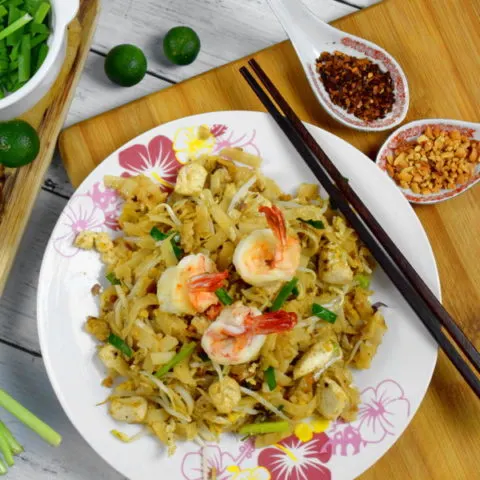
Pad Thai Recipe
This recipe is the upgraded version of the original recipe I posted in 2015. Please read the content of the post for full details.
Ingredients
A- The Noodles
B- The sauce
- 35 g palm sugar
- 2 tablespoons tamarind paste
- 2 tablespoons fish sauce
- 3 tablespoons water
C- The main ingredients
- 6 prawns, deveined and shelled, use medium to large
- 1 shallot, thinly sliced
- 2 cloves garlic, chopped
- 1 tablespoon dry shrimps, chopped and soaked in water
- ½ teaspoon chili flakes
- 1 tablespoon sweet preserved radish, chopped
- 2 cups bean sprouts
- 1 pressed tofu, cut into small pieces, about 150g
- 2 eggs
D- Other ingredients
- 2 stalks Chinese chives, cut into 2” pieces
- 2 tablespoons peanuts, roasted and coarsely chopped
- 1 lime, halves
- 3 tablespoons vegetable oil
Instructions
- Cut the Chinese chives into 2cm length.
- Wash the bean sprouts with water.
- Clean and devein the prawns.
- Cut the tofu into 2cm length julienne.
- Heat up some vegetable oil in the wok. Fry the tofu until golden brown. Set aside.
- Pan fry the prawns over low to medium heat until both sides turn golden brown. Do not move the prawns around in the wok so that they are sheared nicely. Flip over only once should be good enough. Remove the shrimps and set aside.
- Saute and chopped shallots and minced garlic over low heat until fragrant with the prawn oil. Add the dry shrimps, chili flakes, and preserved radish.
- Add the soaked, drained noodles to the wok. Stir and mix with the sauteed ingredients. Then add the Pad Thai sauce. Stir-fry over medium heat for a minute.
- Add 2/3 of the bean sprouts and continue frying over high heat.
- Push the noodles to the side of the wok. Add a small amount of oil to the center and make an omelet. Scramble the egg and mix with the noodles.
- Add half of the crushed peanuts.
- Add the Chinese chives.
- Finally, add the remaining bean sprouts to the noodles and turn off the heat immediately. Dish up and serve.
Recommended Products
As an Amazon Associate and member of other affiliate programs, I earn from qualifying purchases.
-
 Tamicon Tamarind Paste
Tamicon Tamarind Paste -
 Red Boat - Fish Sauce, 8.45 Ounce - Chef’s Grade, Gluten Free, Sustainably Sourced & Artisan Processed, 100% Pure, Protein Rich, No Added MSG or Preservatives.
Red Boat - Fish Sauce, 8.45 Ounce - Chef’s Grade, Gluten Free, Sustainably Sourced & Artisan Processed, 100% Pure, Protein Rich, No Added MSG or Preservatives. -
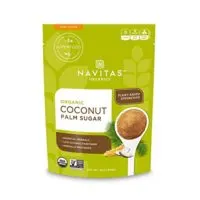 Navitas Organics Coconut Palm Sugar, 16 oz. Bag — Organic, Non-GMO, Gluten-Free, Sustainable
Navitas Organics Coconut Palm Sugar, 16 oz. Bag — Organic, Non-GMO, Gluten-Free, Sustainable -
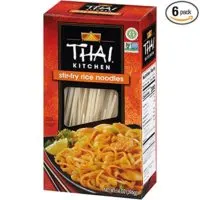 Thai Kitchen Gluten Free Stir Fry Rice Noodles, 14 oz, Pack of 6
Thai Kitchen Gluten Free Stir Fry Rice Noodles, 14 oz, Pack of 6
Nutrition Information:
Yield: 2 Serving Size: 2 servingsAmount Per Serving: Calories: 725Total Fat: 35gSaturated Fat: 5gTrans Fat: 1gUnsaturated Fat: 27gCholesterol: 227mgSodium: 1827mgCarbohydrates: 80gFiber: 6gSugar: 28gProtein: 28g
This data was provided and calculated by Nutritionix on 5/23/2019

Drunken noodles- How to make Thai spicy noodles (proven recipe)
Wednesday 19th of February 2025
[…] like drunken noodles, you will be most likely also interested in the following related Thai dishes:Pad Thai is a stir-fried rice noodle dish similar to drunken noodles but uses dried shrimps, groundnuts, […]
Thai vegetable stir-fry- a quick and easy authentic Thai recipe
Saturday 21st of December 2024
[…] Pad Thai is the most common traditional Thai stir-fried noodle dish. Try this if you have never cooked Thai noodles before. […]
Pad Kra Pao - How to stir-fry pork with Thai basil (amazing Thai recipe)
Friday 4th of October 2024
[…] Pad Thai – traditional Thai-style fried noodles. […]
Doug
Friday 29th of March 2024
WAAY too much sauce. This recipe tastes of nothing other than sauce.
Joan Murray
Thursday 23rd of May 2019
Thank you for recipes I just love them.
KP Kwan
Friday 24th of May 2019
Hi Joan, You are welcome. Enjoy you Pad thai :) KP Kwan